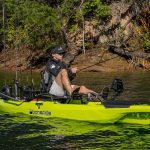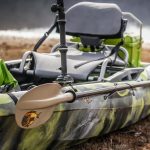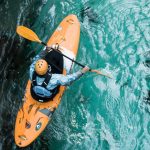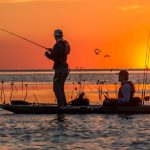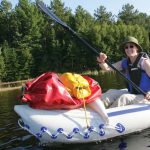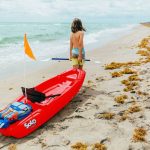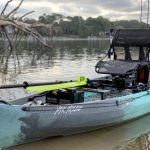Founded in 2016, Bonafide Kayaks is a relative newcomer to the kayak fishing market. 100% made in the USA, their kayaks are known for uncompromised quality and great stability. Let's see what Bonafide Kayaks has to offer in 2023.
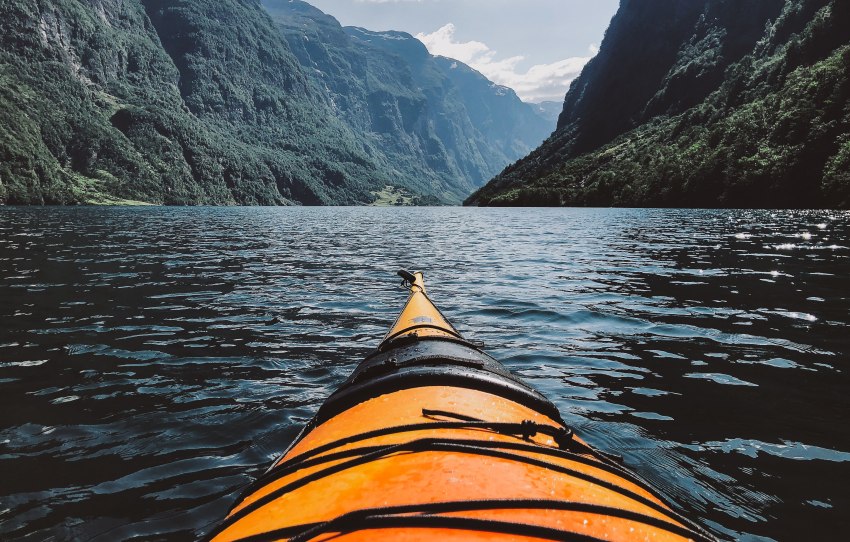
Once your local lake or river starts to feel a little small for you, it may be time to broaden your kayaking horizons. Long days on the water covering many miles, or overnight adventures camping under the stars all become more enjoyable and comfortable with the right touring kayak.
Touring kayaks are fast, sleek, and comfortable. Their hulls are designed to carry the load and cover the distance almost effortlessly.
In this guide, we’re going to review the best touring kayaks and look at all those features you should consider when it comes to buying your new touring kayak.
As an affiliate of Amazon and other retailers, we may earn a small commission when you buy via our links, at no additional cost to you. Thank you!
At a Glance: Best Touring Kayaks
- Eddyline Fathom
- Delta Kayaks Delta 16
- Dagger Stratos 14.5
- Riot Enduro 14
- Perception Kayak Carolina 14
- Eddyline Equinox
- Sea Eagle 393RL
- Oru Kayak Coast XT
Comparison table: Best Touring Kayaks
| Model | Specs | Where To Buy |
Eddyline Fathom | Size: 16′ 6″x 22″ Weight: 50 lbs Capacity: 340 lbs | Eddyline |
 Delta Kayaks Delta 16 | Size: 16’ x 22” Weight: 49 lbs. Capacity: 330 lbs. | REI |
Dagger Stratos 14.5 | Size: 14’ 6” x 24.5” Weight: 53 lbs. Capacity: 300 lbs. | Dagger |
Riot Enduro 14 | Size: 11′ 8″ x 27″ Weight: 59 lbs Capacity: 351 lbs | Amazon |
Perception Kayak Carolina 14 | Size: 14′ x 24.5″ Weight: 53 lbs Capacity: 300 lbs | Amazon |
Eddyline Equinox | Size: 14′ x 25″ Weight: 45 lbs Capacity: 360 lbs | Olympic Outdoor Center |
Sea Eagle 393RL | Size: 12′ 10″ x 28″ Weight: 35 lbs Capacity: 500 lbs | Amazon |
Oru Kayak Coast XT | Size: 16’ x 25” Weight: 36 lbs. Capacity: 400 lbs. | Amazon |
Best Touring Kayaks for 2023
Eddyline Fathom

Length: 16′ 6″ (503 cm)
Width: 22″ (56 cm)
Material: ABS Plastic
Weight: 50 lbs. (22.5 kg)
Capacity: 340 lbs. (154 kg)
Fathom is Eddyline’s top-level touring kayak. It comes with all the necessary components to make it competitive in the sea kayaking world. The strong V-shaped hull is completed with hard chines and a low but balanced rocker. All of this combines to give you a kayak that tracks through even the strongest wind but can turn smoothly and retain a high level of secondary stability.
A drop-down skeg enhances your tracking, keeping you straight in ocean swell or strong winds. This is adjustable so you can control the level of skeg you are using at any time.
Fathom is fitted with two large hatches, one at the bow and one at the stern, for your camping equipment. Behind the cockpit is a smaller day hatch. It is the best place for small items that need to be close at hand on your trip.
These hatches are separated from the cockpit by watertight bulkheads. On the top deck of the kayak, there are reflective deck lines around the edge, which are crossed with bungees for extra storage. These deck lines can be used for rescues, storing spare paddles, or clipping equipment.
All the fittings on the top deck are recessed, so you won’t snag as you climb back into your kayak. The handles at either end, too, are retractable. This means that you can kayak without any additional drag in the water, or handles flapping around your top deck.
The infinity seat system from Eddyline is comfortable and low profile, giving you maximum space inside the cockpit. As standard, this kayak comes with a backrest, while the more adjustable and connective backband is an optional extra. Internally, an adjustable footrest adds to the support and connection.
Pros:
- High end touring kayak with sea capabilities
- Lots of storage space
- Strong and responsive
- Fast and elegant
Cons:
- Narrow design makes it unstable for beginner paddlers
- Expensive
Delta Kayaks Delta 16

Length: 16′ (488 cm)
Width: 22″ (56 cm)
Material: ABS Plastic
Weight: 48 lbs. (21 kg)
Capacity: 330 lbs. (150 kg)
Delta 16 is the mid-sized kayak from Delta’s top-end touring range. These kayaks are slightly narrower and longer than their mid-range boats. This makes them faster over the ground and better suited to tight maneuvers.
Delta 16 has a low rocker profile that helps it grip the water as you paddle. This combines excellently with the defined keel line, to keep you tracking straight on your journey. The narrow, elongated waterline helps the Delta 16 to carry speed easily over the water.
The three hatches on the top deck have a press-lock closure and hard outer shells. These hatches keep your gear safe and secure on the water, whether you’re on an overnight trip or a day out.
Deck lines around the outside of the top deck are recessed, so you don’t snag on them as you climb back into your kayak. There are raised lines behind the cockpit so you can fit your paddle through easily in the event of needing a paddle float rescue. At the bow and stern are paddle parks, for your paddle and spare paddle to be stowed securely.
The Contour II seating system has a fully adjustable backrest. This provides a high level of support in a range of positions, so you can always stay comfortable on the water.
A skeg, or rudder, can be fitted as an optional extra.
Pros:
- Sleek and fast kayak
- Adjustable and supportive seating
- Press-lock hatches with hardcovers
Cons:
- Beginners may struggle with the stability
- Rudders or skegs are extra
Dagger Stratos 14.5

Length: 14′ 6″ (442 cm)
Width: 24.5″ (62 cm)
Material: Rotomolded Polyethylene
Weight: 57 lbs. (26 kg)
Capacity: 315 lbs. (143 kg)
Stratos is a kayak that has something to offer paddlers of any level. The midsection is wider and less severely v-shaped than many touring kayaks. This makes it more stable and forgiving for beginners.
With a sharp v-shape at either end, though, the Stratos can still carry speed over the water and track effectively in the wind. At the bow, there is just enough of a rocker kick to keep the Stratos above the water when surfing. This makes it excellent in rock gardens and ocean surf.
If you’re going to take a kayak in and around the rocks, it’s good to know that it can withstand a bit of abuse. The Stratos is made from rotomolded polyethylene. It may be heavier than other kayaks, but knowing that your kayak is robust will take a weight off your mind.
The ConTour outfitting from Dagger is adjustable, supportive, and comfortable. The floating back band is fully adjustable and the seat system comes with leg raisers to optimize both comfort and blood flow. Thigh braces, hip pads, and footrests complete the outfitting to give you maximum control of your kayak.
A height-adjustable TruTrack skeg system helps you to track in a straight line in wind or current. Two large, watertight hatches make up the bulk of the storage. Lines around the top deck are laced with bungee for extra storage and safety in a rescue situation.
Pros:
- Robust rotomolded polyethylene
- Stable and forgiving for beginners
- Adjustable and connective outfitting
Cons:
- Heavy
- Low top speed compared with others on this list
Riot Enduro 14

Length: 11′ 8″ (355 cm)
Width: 27″ (69 cm)
Material: Plastic
Weight: 59 lbs. (27 kg)
Capacity: 351 lbs. (159 kg)
Riot Enduro 14 is a wide, stable touring kayak that at first glance, looks a lot like a touring kayak. This broad design suits beginners, who will appreciate how stable the Enduro is when you launch or land.
This might not be a kayak that you’re going to cover enormous distances in, but it’s spacious and comfortable. You can easily stay out on the water all day with the large cockpit and Flex4 seat. The fully adjustable backrest and extra thick seat pad are both designed to shed water, so you won’t find yourself sitting in a puddle all day.
The grooved hull and drop-down skeg system let you balance tracking against maneuverability in the Enduro 14. It’s suitable for a range of conditions, and one of the better-suited kayaks on this list for gentle rivers.
Front and rear watertight hatches give you plenty of space to store your equipment out on the water. Deck lines on the top of this kayak let you keep certain items close to hand.
Just behind the cockpit, you’ll find a rod holder. The Enduro is a touring kayak first and foremost, but it can be used as a fishing kayak if you want to travel a bit further to find your perfect spot.
Pros:
- Lots of storage space
- Water-resistant and adjustable outfitting
- Rod holder for touring anglers
- Affordable
Cons:
- Short stature limits the top speed
- Relies heavily on the skeg for tracking
- Heavy
Perception Kayak Carolina 14

Length: 14′ (427 cm)
Width: 24.5″ (62 cm)
Material: Rotomolded plastic
Weight: 53 lbs. (24 kg)
Capacity: 300 lbs. (136 kg)
Perception Carolina 14 focuses on a comfortable and stable ride. This stability starts as you enter the water and continues through your journey. The Carolina 14 can easily accommodate larger paddlers and is suitable for a wide range of different types of water.
The hull is reasonably long, with a clearly defined keel at either end and a low rocker profile. This profile means that the Carolina 14 tracks effectively and turns smoothly. It might not be the longest, fastest kayak on this list, but it balances speed against your comfort, keeping you out on the water for long days.
The Zone DLX seating system from Perception Kayaks is one of the most adjustable touring seats around. The backrest can be moved up and down, as well as forwards and backward, and the seat base is tilt adjustable. This lets you find the perfect position to stay connected and in control, but also to maximize your comfort and stay out for longer.
The Carolina 14 comes with two watertight hatches for storage. Deck lines and bungee are fitted for safety and additional storage. This kayak is rudder-ready, giving you greater control over your turning and tracking.
Pros:
- Comfortable and stable kayak which is suited to beginners
- Suited to a range of types of water
- Robust enough to withstand years of use
Cons:
- Flatter central area limits the top speed
Eddyline Equinox

Length: 14′ (427 cm)
Width: 25″ (63 cm)
Material: ABS Plastic
Weight: 45 lbs. (20 kg)
Capacity: 360 lbs. (163 kg)
Eddyline Equinox combines the hull shape and speed of a true sea kayak with the comfort and width of a recreational kayak. This kayak is easy to get in and out of, as well as launch and land. Don’t be fooled though, it can still cover ground quickly and track through the wind with ease.
Made from ABS plastic, the Equinox is lightweight and has the level of stiffness and response you would expect from a fiberglass kayak. Unlike the Fathom, the Equinox is better suited to inshore lakes and slow-moving rivers, rather than long trips offshore. The shorter stature and extra rocker let you bounce through waves more easily, but do limit the top speed and tracking abilities a little.
The Infinity seating system slides forwards and backward for easy adjustment and secures in place in your chosen spot. The Equinox comes with a backrest as standard, but you can upgrade this to a backband if you choose. Adjustable footpegs inside the kayak keep you securely in your seat.
Two storage hatches, at the bow and stern, provide plenty of space to stow away your equipment. Deck lines and bungee with recessed attachment points offer additional, snag-free storage.
Pros:
- Excellent all-around touring kayak
- Stable and well suited to beginner paddlers
- Good level of tracking
Cons:
- No skeg or rudder system
- Expensive
Sea Eagle 393RL

Length: 12′ 10″ (391 cm)
Width: 28″ (71 cm)
Material: 1100 Decitex Reinforced
Weight: 35 lbs. (16 kg)
Capacity: 500 lbs. (227 kg)
Inflatable kayaks have progressed a long way in the past few years. New technology and design have taken inflatables from recreational toys to a highly competitive touring kayak. Sea Eagle is at the cutting edge of this design, with their RazorLite series.
Sea Eagle 393RL is the smaller of the series, but at almost 13 feet long, it can carry speed smoothly over the water. The whole kayak is designed with drop stitch technology, which allows it to be inflated to a higher pressure. High-pressure inflatable kayaks perform similarly to plastic kayaks and are responsive, fast, and can track well through the wind.
ALSO SEE: Best Inflatable Kayaks for 2023 // Reviews & Buying Guide
The addition of a hardened plastic bow and keel line to the 393 RL makes this tracking even closer to a hardshell kayak. A swept-back removable skeg at the rear will help if you’re going out in windy conditions.
Although it’s wide when compared with other kayaks on our list, the 393 RL is narrow for an inflatable kayak. It’s designed with intermediate paddlers in mind and beginners may find that it’s not as stable as they would like.
The key advantage to this inflatable kayak is how easy it is to store and transport. Once deflated, the 393 RL fits easily into the trunk of a car or can be stored in a cupboard at home. Inflation time is under 7 minutes.
The 393 RL is an open-top style kayak, so you lose out on the protected cockpit of the other kayaks on this list. Spray skirts at the ends go some way to limiting the amount of water that can get into the kayak, while drain bungs let you empty it on the move. There are four D-rings fitted for connecting the removable seat.
Pros:
- Fast and excellent tracking for an inflatable
- Easy to store and transport
- Versatile and suited to a range of water types
Cons:
- Open deck style kayaks don’t offer the same level of weather protection
- Not as suited to long trips and gear carrying as other kayaks on this list
Oru Kayak Coast XT

Length: 16′ (488 cm)
Width: 25″ (64 cm)
Material: Corrugated Polypropylene
Weight: 36 lbs. (16 kg)
Capacity: 400 lbs. (181 kg)
Oru Kayak Coast XT is a folding kayak that can pack down to the size of a large suitcase. Once folded away, this kayak fits easily into the trunk of your car or the hold of an airplane. With the additional purchase of the kayak pack, you can even hike this kayak into remote regions.
Once fully unfolded and assembled, the Coast XT takes on the feel of a rigid kayak. There is full outfitting, including a seat with a backrest, thigh braces, and footpegs. There are deck lines and bungee on the top deck, for safety and extra storage.
Coast XT is made from double layer extruded polypropylene. It can withstand sliding over rocks and beaches without damage. The improved zipper channel closure system has reduced assembly time, too, so you can get onto the water sooner.
The keel line and low rocker profile of the Coast XP mean it does track well enough through the water. With a limited weight, it will be more affected by wind than other kayaks on this list.
Removable bulkheads give the kayak more structure, but also organize your internal equipment and help to limit flooding if you capsize. These bulkheads aren’t fully watertight, but they will slow down how quickly your kayak fills up. The Coast XP can be used with an Oru spray skirt and can even be rolled in the event of a capsize.
Pros:
- Easy to transport
- Lightweight
- High capacity and internal storage
Cons:
- Weight could make it more wind affected
- No watertight bulkheads
What is a touring kayak and where can you paddle one?
Touring kayaks are like the ATVs of the kayaking world. These kayaks are capable of all different types of water. There are touring kayaks that are more suited to white water, or open ocean, but most are designed to be used on gentle rivers, inland open water, and coastal areas.
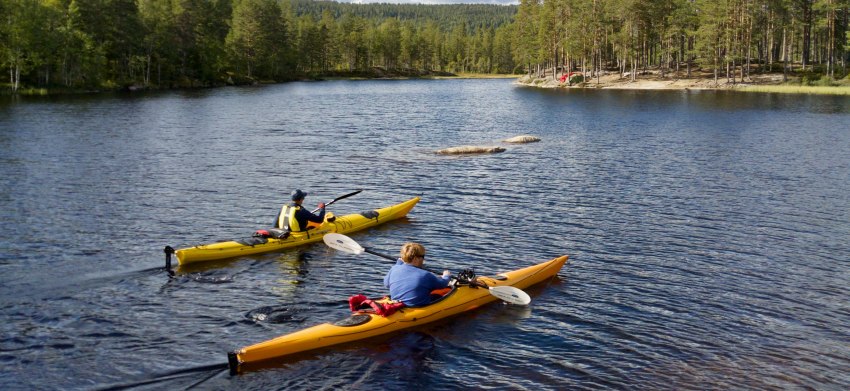
This means that you can paddle a touring kayak just about anywhere you want. They have certain safety features that we will look at short and storage for your equipment. Touring kayaks are your step into overnight, expedition kayaking.
Touring kayaks vs Sea kayaks: What are the differences?
Sometimes, telling the difference between a touring kayak and a sea kayak is difficult. That might be because, in their hearts, they’re almost the same thing.
In a similar way to how some touring kayaks are designed to tackle more advanced white water, there are touring kayaks designed to navigate the open ocean. It can be easiest to think of sea kayaks as touring kayaks with enhanced features. These features make sea kayaks safe to take into open seas and harsher environments.
If you’re interested in the best sea kayaks, check out our post here.
What are the features of a touring kayak hull?
The hull shape of a touring kayak varies between models. Some features are found on most, if not all, touring kayaks though.
V-shaped hull
Most touring kayaks come with either a full or partial, v-shaped hull. A pronounced keel line on a kayak will make it track better in the wind or in current and means you have to use less energy on correction strokes.
RELATED: How to Paddle a Kayak: Basic Paddle Strokes
A full V-shaped hull is more streamlined than a flatter hull. V-shaped kayaks have a higher top speed and glide more smoothly over the water. A V-shaped hull has limited primary stability, though, and beginners may find they feel unstable when stationary.
Long keel line
There is a general rule that longer kayaks are faster than shorter kayaks. This will be affected a little by the hull shape. Touring kayaks are usually between 12 and 16 feet and are among the fastest kayaks on the market.
Beginner-friendly touring kayaks are usually around 14 feet long and are usually wider than their 16 feet long counterparts. The length of your kayak affects speed, capacity, storage space, and stability. It also has an impact on tracking, although this largely depends on hull shape and rocker.
Chines
Chines connect the hull of your kayak to the sidewalls. Kayaks are either described as being either hard or soft chined.
Hard-chined kayaks feel more squared off and less stable when they are flat and stationary. Hard chined kayaks have higher secondary stability, so you can lean them through a turn. This is a feature of higher-end touring kayaks, with sharp v-shaped hulls.
Soft chined kayaks feel more stable and forgiving. They usually roll from side to side, rather than quickly changing between flat and being on an edge. Soft chined touring kayaks are often better suited to shorter open water trips and slow-moving rivers.
Rocker
Kayak rocker is the amount of curvature from the front to the back of the kayak. A low rockered kayak is flatter, while a kayak with a high rocker looks more like a banana.
Many touring kayaks have a low rocker profile. This means that the bow of the kayak can grip the water and track more effectively in the wind or current.
A kayak with a higher rocker can be better in waves or moving water. They ride higher, cruise over waves, and are more maneuverable in a tight space. Touring kayaks that are designed for ocean surf, or rivers, tend to have more rocker.
What are touring kayaks made from?
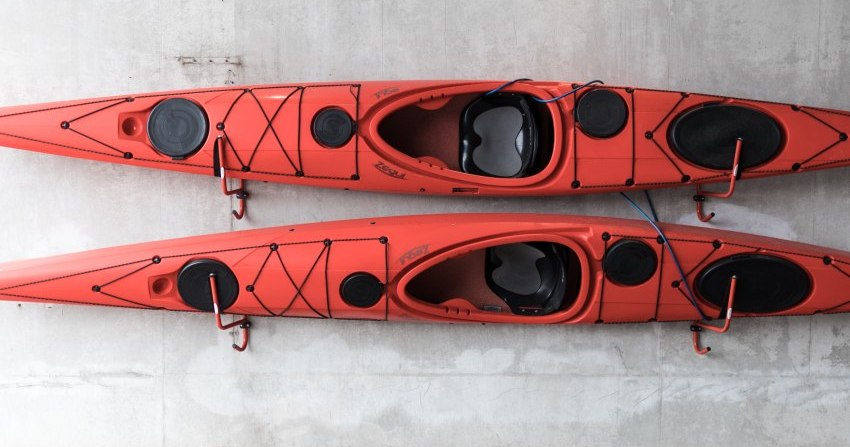
Polyethylene
Rotomolded polyethylene kayaks are the most robust but heaviest touring kayaks on the market. Plastic kayaks are the cheapest material to make kayaks from and for that reason, they are usually the choice of beginners and intermediate paddlers.
Plastic touring kayaks are diverse. They are strong enough to stand up to white water rivers, ocean surf, and heavy beach landings. The weight will become noticeable on longer journeys, though.
ABS
A sheet of ABS plastic, usually coated with an acrylic layer, is heated and then molded onto a plug. ABS is lighter and in many ways more durable than polyethylene. It’s not as well suited to rocky environments and beach landings though.
ABS is the most common material used for touring kayaks, especially intermediate to top-end models. It is stiff and responsive enough to be used in challenging weather. The low weight means you can paddle an ABS kayak all day without exhausting yourself.
Composites
Carbon, kevlar, and fiberglass can all be blended in a variety of ways to make stiff and extremely lightweight kayaks. They are expensive and not as durable as ABS models though. Composite kayaks are mainly used by true enthusiasts, who can justify the price tag with their regular use in demanding environments.
Comfort is key
Long days on the water call for a kayak that you can get comfortable in. The outfitting of touring kayaks varies, but they usually have a padded seat, backrest or backband, some kind of thigh braces, and footrests.
With high-end, fully adjustable outfitting, you can enhance your control of the kayak without losing comfort. Some models focus on freedom of movement though, cutting back the outfitting so you can move your legs around and keep the blood flowing as you paddle.
Either way, you should find a kayak that is comfortable for you and one that you can stay in for long periods. Features like airflow on the seats and backband, or a waterproof seat and a spray skirt can be a bonus and avoid you getting too warm, or sitting all day in a puddle.
Storing equipment in your touring kayak
Day trips and overnight expeditions both require a certain amount of equipment to be carried with you. Most touring kayaks will have between one and three watertight hatches to stow your equipment and keep it dry and secure. These are separated by bulkheads, which we will look at shortly.
Smaller items and those you need close at hand, like bilge pumps, spare paddles, and sponges, can often be stored on the top deck. Bungee often crosses between the deck lines and will secure your equipment in place.
Remember that everything you carry adds to your weight. The capacity of a kayak includes you as the paddler and everything you carry. To maintain optimum performance from your kayak, you should not exceed 70% of your kayak’s weight capacity.
Bulkheads
The bulkheads that separate your storage areas from one another and your cockpit have an essential safety purpose. If you capsize and swim out of your kayak, these watertight bulkheads will stop the water from flooding and swamping your whole boat.
If your bulkheads are fully watertight and your hatches are sealed, the only area of your kayak that will fill with water is the cockpit. You can climb back into your kayak either by self-rescuing, or with help from another kayaker. Once in your kayak, you can pump the water out of your cockpit and continue paddling.
Without watertight bulkheads, your entire kayak swamps and rescue becomes more difficult. Self-rescues are almost impossible without solid, watertight bulkheads.
Skegs or rudders
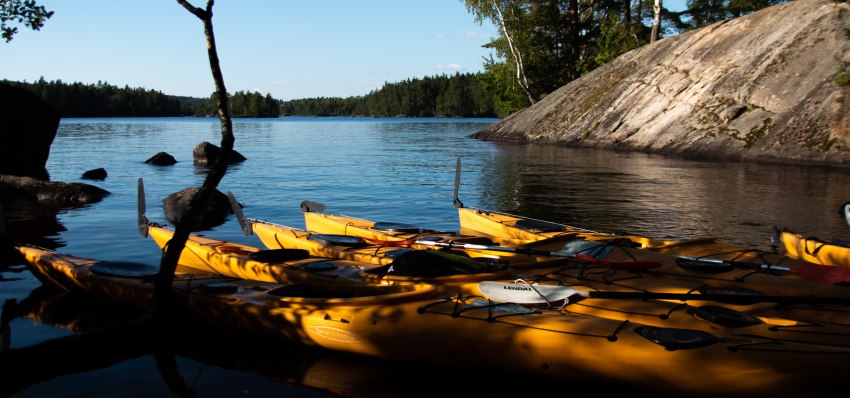
Skegs and rudders are common on touring kayaks. Skegs are used to help the tracking capabilities of your touring kayak. These can be raised and dropped from the cockpit so you can keep your kayak on course against the wind.
Rudders give you the ability to turn your kayak without breaking stride in your paddling. These are controlled by pedaling your feet to turn the rudder and turn the kayak. Rudders can usually be raised or lowered and if they’re kept central, will help your tracking too.
Learn more about differences and benefits of kayak rudders and skegs in our dedicated post.

